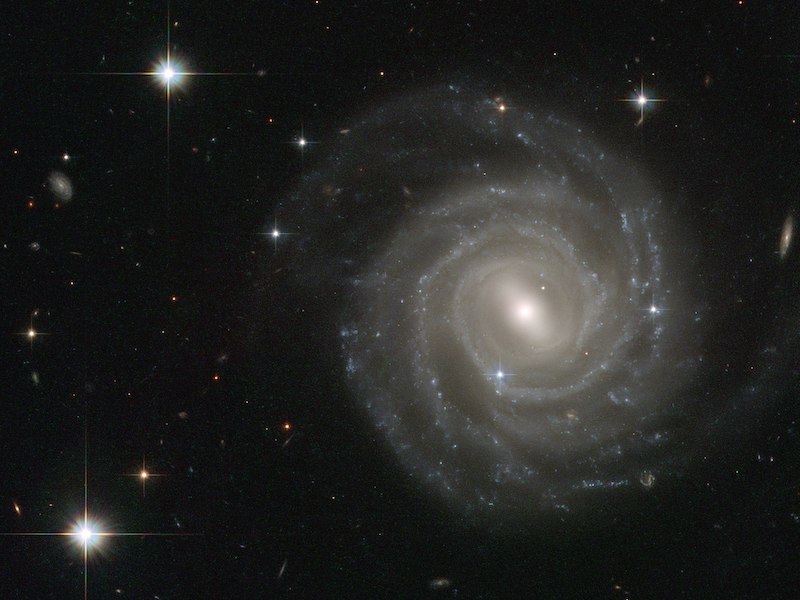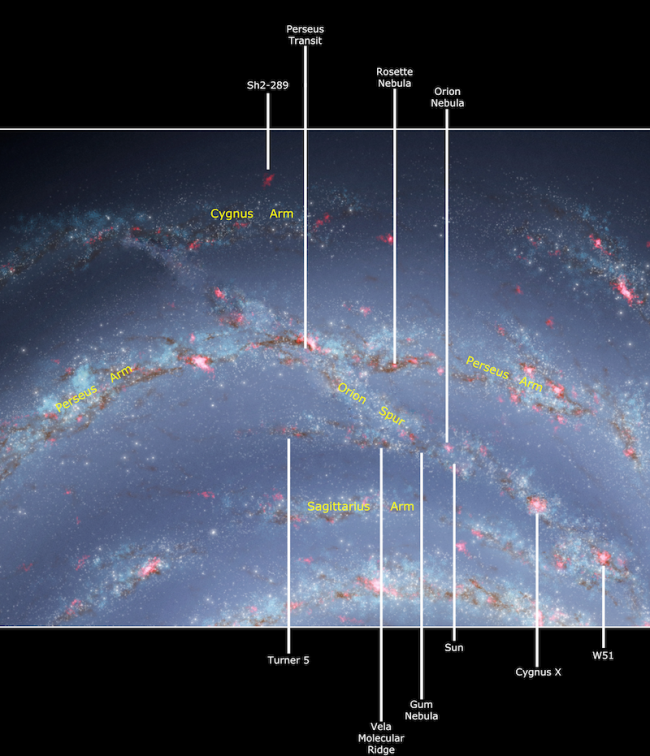Where do we live in the Milky Way? We live between two major spiral arms. Our solar system is located on a minor spiral arm: the Orion Arm.
The 2024 lunar calendars are here! Best New Year’s gifts in the universe! Check ’em out.
Which spiral arm of the Milky Way is ours?
Our Milky Way galaxy is the island of stars we call home. If you imagine it as a disk with spiral arms emanating from the center, our sun is approximately halfway from the center to the visible edge. Our solar system lies between two prominent spiral arms: the Perseus Arm and the Scutum-Centaurus Arm. But we aren’t quite free floating in empty space. We lie on the edge of a relatively minor spiral arm, the Orion-Cygnus Arm, or simply, the Orion Arm or Local Arm.
In Michael Carroll’s book Planet Earth, Past and Present: Parallels Between Our World and its Celestial Neighbors, he explains why our position in the galaxy might be important to life on Earth. He writes:
Our location in the galaxy is significant, as it appears that – like planetary systems – galaxies have habitable zones.
An astonishing 95% of the Milky Way’s suns may not be able to sustain habitable planets, because many orbit the galaxy in paths that carry them through the deadly spiral arms. Any star that passes through one of these starry swarms is subject to deadly radiation from the congested stars. Our own solar system orbits far enough from the center to keep it in sync with the rotation of the rest of the galaxy, so that it remains in the quieter space between the spiral arms. The Earth and its planetary siblings are well placed in a quiet, resource-rich niche of a vast and complex galaxy.
The structure of the Milky Way
The Milky Way is a barred spiral galaxy, which means it has a central bar. There’s still a lot we don’t know about the structure of our galaxy. According to the best current knowledge, the Milky Way is about 100,000 light-years across, about 2,000 light-years deep, and has 100 to 400 billion stars. Astronomers once thought that our spiral galaxy had four major arms, but now they say we have just two major arms and many minor arms.
Where, within this vast spiral structure, do our sun and its planets reside? We’re about 26,000 light-years from the center of the galaxy, on the inner edge of the Orion-Cygnus Arm.

The Orion Arm
The Orion Arm of the Milky Way is probably some 3,500 light-years wide. Initially, astronomers thought it was about 10,000 light-years in length. But a study from 2016 suggests it’s more than 20,000 light-years long.
Astronomers continue to piece together the structure of the Milky Way by painstakingly measuring the positions and distances to many stars and gas clouds. Telescopes on the ground and in space determine distances from parallax measurements. For example, the Gaia space telescope’s goal is to provide a 3-dimensional map of our Milky Way.

How our local spiral arm got its name
The Orion Arm gets its name from the constellation Orion the Hunter, which is one of the most prominent constellations of the Northern Hemisphere winter (Southern Hemisphere summer). Some of the brightest stars and most famous celestial objects of this constellation (Betelgeuse, Rigel, the stars of Orion’s Belt, the Orion nebula) are neighbors to our sun. The reason we see so many bright objects within the constellation Orion is because when we look at it, we’re looking into our own local spiral arm.

Bottom line: Where do we live in the Milky Way galaxy? We lie between the major arms in a smaller spiral arm known as the Orion Arm.
The post Which spiral arm of the Milky Way is ours? first appeared on EarthSky.
from EarthSky https://ift.tt/ZJTOHnl
Where do we live in the Milky Way? We live between two major spiral arms. Our solar system is located on a minor spiral arm: the Orion Arm.
The 2024 lunar calendars are here! Best New Year’s gifts in the universe! Check ’em out.
Which spiral arm of the Milky Way is ours?
Our Milky Way galaxy is the island of stars we call home. If you imagine it as a disk with spiral arms emanating from the center, our sun is approximately halfway from the center to the visible edge. Our solar system lies between two prominent spiral arms: the Perseus Arm and the Scutum-Centaurus Arm. But we aren’t quite free floating in empty space. We lie on the edge of a relatively minor spiral arm, the Orion-Cygnus Arm, or simply, the Orion Arm or Local Arm.
In Michael Carroll’s book Planet Earth, Past and Present: Parallels Between Our World and its Celestial Neighbors, he explains why our position in the galaxy might be important to life on Earth. He writes:
Our location in the galaxy is significant, as it appears that – like planetary systems – galaxies have habitable zones.
An astonishing 95% of the Milky Way’s suns may not be able to sustain habitable planets, because many orbit the galaxy in paths that carry them through the deadly spiral arms. Any star that passes through one of these starry swarms is subject to deadly radiation from the congested stars. Our own solar system orbits far enough from the center to keep it in sync with the rotation of the rest of the galaxy, so that it remains in the quieter space between the spiral arms. The Earth and its planetary siblings are well placed in a quiet, resource-rich niche of a vast and complex galaxy.
The structure of the Milky Way
The Milky Way is a barred spiral galaxy, which means it has a central bar. There’s still a lot we don’t know about the structure of our galaxy. According to the best current knowledge, the Milky Way is about 100,000 light-years across, about 2,000 light-years deep, and has 100 to 400 billion stars. Astronomers once thought that our spiral galaxy had four major arms, but now they say we have just two major arms and many minor arms.
Where, within this vast spiral structure, do our sun and its planets reside? We’re about 26,000 light-years from the center of the galaxy, on the inner edge of the Orion-Cygnus Arm.

The Orion Arm
The Orion Arm of the Milky Way is probably some 3,500 light-years wide. Initially, astronomers thought it was about 10,000 light-years in length. But a study from 2016 suggests it’s more than 20,000 light-years long.
Astronomers continue to piece together the structure of the Milky Way by painstakingly measuring the positions and distances to many stars and gas clouds. Telescopes on the ground and in space determine distances from parallax measurements. For example, the Gaia space telescope’s goal is to provide a 3-dimensional map of our Milky Way.

How our local spiral arm got its name
The Orion Arm gets its name from the constellation Orion the Hunter, which is one of the most prominent constellations of the Northern Hemisphere winter (Southern Hemisphere summer). Some of the brightest stars and most famous celestial objects of this constellation (Betelgeuse, Rigel, the stars of Orion’s Belt, the Orion nebula) are neighbors to our sun. The reason we see so many bright objects within the constellation Orion is because when we look at it, we’re looking into our own local spiral arm.

Bottom line: Where do we live in the Milky Way galaxy? We lie between the major arms in a smaller spiral arm known as the Orion Arm.
The post Which spiral arm of the Milky Way is ours? first appeared on EarthSky.
from EarthSky https://ift.tt/ZJTOHnl

Aucun commentaire:
Enregistrer un commentaire